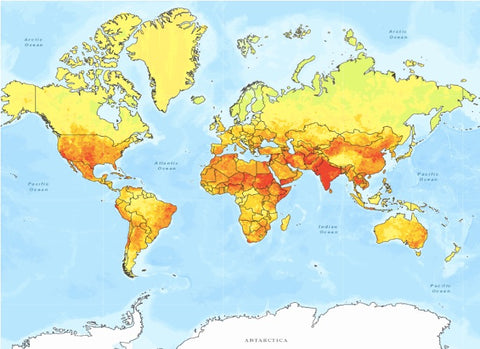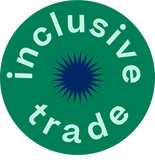World Desertification and Drought Day
- Inclusive Trade thanks Lidia Callejo, a passionate environmental and sustainable lifestyle enthusiast for this article.
World Desertification and Drought Day and the fashion industry
This UN observance day aims to raise awareness on desertification and drought, the environmental issue which threatens what has been referred to as the foundation of life - soil. Before going further, let us clarify what desertification and drought are. The UN Convention to Combat Desertification (UNCCD) is the governing body at a global scale that focuses on this environmental issue. They define desertification as:
“the degradation of land in arid, semi-arid, and dry sub-humid areas. It is a gradual process of soil productivity loss and the thinning out of the vegetative cover because of human activities and climatic variations such as prolonged droughts and floods… the land's topsoil… takes centuries to build up. Among human causal factors are overcultivation, overgrazing, deforestation, and poor irrigation practices.”
June 17th of each year is observed as the Desertification and Drought day. This year´s focus re-enforces the notion of our livelihoods being threatened. The slogan “Food.Feed.Fibre” demonstrates links between consumption and land. It puts the spotlight on the main driver of this environmental crisis, which is our unsustainable habit of mass production and mass consumption. Both, which have also resulted in record levels of waste. Furthermore, it reminds us on our dependence on nature, on soil, to meet the demand for food and clothing.
“If we keep producing and consuming as usual, we will eat into the planet’s capacity to sustain life until there is nothing left but scraps. We all need to make better choices about what we eat and what we wear to help protect and restore the land.” — Ibrahim Thiaw, Executive Secretary of the UN Convention to Combat Desertification (UNCCD)
Patricia Espinosa, the Executive Secretary of the United Nations Framework Convention on Climate Change (UNFCCC), made a statement for this year’s World Desertification and Drought Day, which resonated with me. When referring to the earth and its resources (such as soil) which are essential for our livelihood she said,
“....It sustains us, it nurtures us but it is not a one way street, we cannot expect to be taking without giving back....”
Sadly, we have taken more than we should have and have not been giving back enough. This brings us to where we are today, the soil we stand on is under threat and therefore, so are we.
This article today, focuses on the third ‘F- Fibre’
Lets explore how we could overcome this challenge by educating ourselves and encouraging innovation of sustainable fibres and the adoption of responsible consumption. A good place to start often, is at the root of the problem.
So does the fashion industry contribute to desertification and drought? How far and in what capacity?
The answer to this first question is indisputable today, yes it does. The fashion industry plays a significant role in aggravating this problem. More so, ‘fast fashion’ uses large volumes of resources to produce vast amounts of cheap, low-quality garments that feeds of, and at the same time, fuels our throwaway culture. Soil degradation has been associated with many practices in the textile industry including overgrazing of pastures, degradation of soil due to intensive use of chemicals, deforestation caused by wood-based fibers like rayon and overall large amounts of water consumption.
These statistics from the UNCCD shine light onto significance of the fashion industry:
- 90% of Mongolia’s surface is facing the thread of desertification due to the breeding of cashmere goats
- By 2030, the fashion industry is predicted to use 35 per cent more land
- Over 115 million hectares, equivalent to the size of Colombia.
- Clothing and footwear production causes 8 per cent of global greenhouse gas emissions, a figure predicted to rise almost 50 per cent by 2030. (climate change contributes to soil degradation too)
Moreover, the textile industry is very water intensive and has intensified water scarcity in drought-prone areas. Water scarcity in turn exacerbates the effects of desertification through impact on soil quality, structure and moisture levels.
The map below allows for a visual understanding of the linkages between fashion and water risk areas.

Source: WWF Water Risk Map
The map demonstrates areas of high-water level risk, the red areas directly match those areas with significant textile production. (China, India, Bangladesh, Turkey and the Chad River Basin)
However, the objective is not simply to present the issue at hand…
It also has a far more uplifting and positive objective, that is to remind us there is a solution and that it may not be too late! We have degraded vast amounts of our land, but we still have time to address this challenge.
SO what can we do?
When addressing such a large-scale challenge, (that may even be distant or nonexistent to many who do not live close to affected areas nor know those affected negatively by its impact) it may seem like we have a small or insignificant role to play individually. This could not be further away from the truth. As consumers, we have a crucial role to play as agents of change.
Let’s start by taking some UNCCD advice:
• Policy and regulatory environment: While changes at the business and consumer level will shape the demand for change, governments and policy makers must get involved in incentivising sustainable production and consumption. This has already made an impact in the use of safe dyes for fabrics, metals used for example in jewellery and ingredients and processing of food, however the lifecycle of clothing along with the ability to trace the materials in this industry chain is still not required by law. As a result, this has lead to several unsustainable practises over the years. Involvement at the macro policy levels to support change is of utmost important if we are to see a directional change in this industry.
• Change business and corporate buying: By adopting efficient planning and sustainable buying practices, corporates and retailers would make a good start. Producers and manufacturers respond to demand, hence, if buyers use their buying power to signal demand only for sustainable materials and producers only produce what was required, there would be much less waste and less use of materials overall. Tier 1 producers would in turn cut back on sourcing unsustainably from tier 2 suppliers and the chain would continue in a sustainable way. This takes some decision making and strong leadership amongst decision making teams in retail and corporate procurement to make policy changes within their organisations on their sourcing practices. There are several new online and ‘produce to demand’ options that have come up. For example, Inclusivetrade.com works closely with independent artisans and communities to support small capsule pieces, collections and the use of upcycled waste to re-use and re -create beautiful pieces while supporting ethical production methods. Fashion industry manufactures, retailers, investors have all benefitted from nature and societal resources. It is imperative that business comply with responsible and sustainable production standards. A key step is to must sign up to global initiatives that seek to improve production processes both internally and externally. Making the transition to a circular economy offers a great opportunity for sustainability overall. The value and volume of resources that are up for recycling are large and have not been quantified and used appropriately as yet. While several initiatives are being set up, there is still a lack of consolidation and clarity for buyers and consumers alike. The Textile Exchange are doing great work forwarding this through the development of their textile exchange databases which provides a comprehensive list of RCS and/or GRS certified suppliers.
• Changes in individual consumption practices: Responsible consumption can be practiced by each one of us in our own homes. There are multiple options for each one of us to choose from and to follow. UNCCD offers practical guidance, “buy from local markets, swap clothes and consume less. All this can free up land for other uses and lower carbon emissions”. Washing our clothes at 15 degrees or lower for example increases the life of many of our existing clothes. Know your consumption needs: Less is more! opt for quality, durability and sustainability. Know your Fibers and the pros and cons of using certain types of fibres. Keep an eye out for garments with the following certification label controlling chemical content OEKO-TEX, GOTS, BLUESIGN. Start to know your brands. This is perhaps one of the most important elements that a consumer can do to drive change.
Inclusivetrade.com offers a great free resource : 10 step sustainable shopping cheat sheet. Sign up, and get in touch to get your free copy: social@inclusivertade.com
#Shopbyimpact can help you make informed buying decisions…
Inclusivetrade.com connects these spheres of changemakers together. By engaging in global inter-governmental panels at the UN, WTO and global business and academic level, inclusivetrade.com provides direction and advices policy changes that are needed urgently at the macro level.
By joining responsible business with responsible consumers through a #shopbyimpact model, inclusive trade supports artisan brands that exemplify good business practices helping reduce the overexploitation of our natural resources while supporting ethical production models and promoting responsible, traceable and transparent businesses. By connecting every purchase to the goals and aims set out by the United Nations Sustainable Development Goals (SDGs), consumers and corporates can directly see what positive impact their purchase has and can make.
To finish on a positive and encouraging note here are some short (2 mins) videos from the UNCCD, showcasing some innovative and exciting ways the textile industry is reducing water use and implementing circular economy principles and thus addressing desertification and drought.
• https://www.youtube.com/watch?v=huPoP1Fd7y0&list=PLYKtFP8Y-QCn8ZoEu2JLP1cklknisQjF_&index=6
• https://www.youtube.com/watch?v=6v8BtHDq0So&list=PLYKtFP8Y-QCn8ZoEu2JLP1cklknisQjF_&index=14
Links and more references:
Patricia Espinosa full statement https://www.youtube.com/watch?v=8LYZ4YOcJLA
Map: WWF Water Risk Map extracted from WWF Mapping Tool: https://waterriskfilter.panda.org/en/Explore/Map
UNCCD Desertification and Drought Day Page https://www.unccd.int/actions17-june-desertification-and-drought-day/2020-desertification-and-drought-day
This is a great day to shed some light on this issue and to start educating ourselves on what we can do. As a starting point, to get started on your journey to responsible consumption, do sign up to get your own free 10 – step sustainable sourcing cheat sheet email us now: social@inclusivetrade.com
